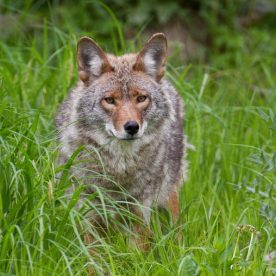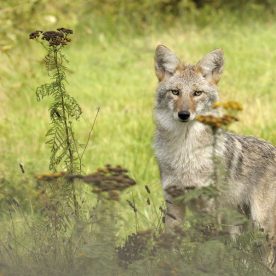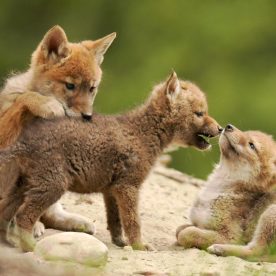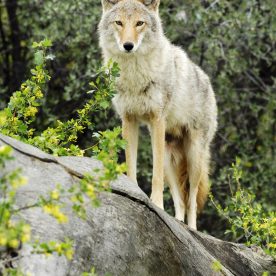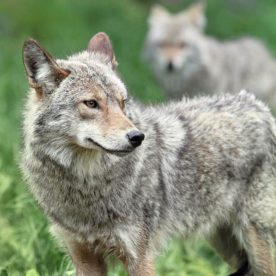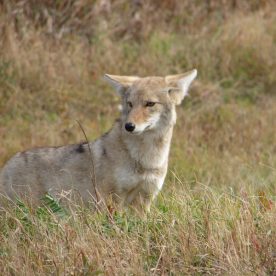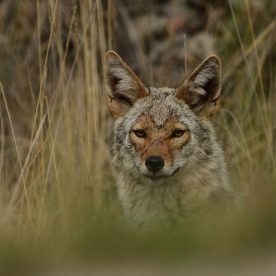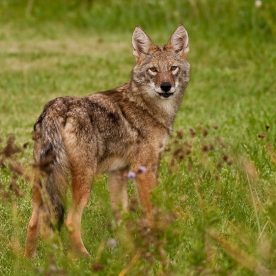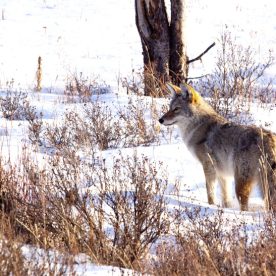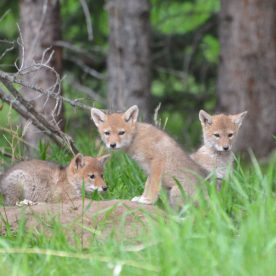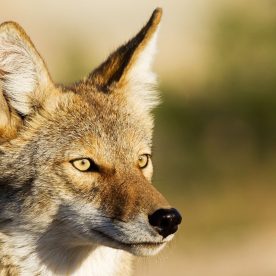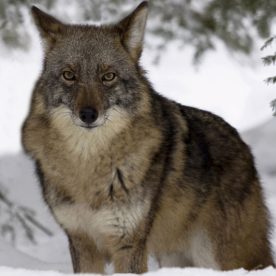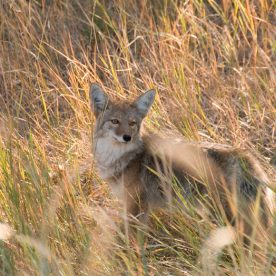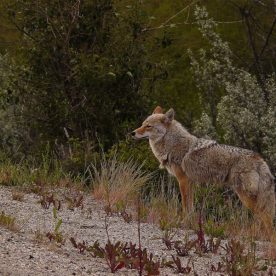Description
The coyote Canis latrans is one of the seven representatives of the Canidae family found in Canada. Other members of the family are the wolf, red fox, arctic fox, grey fox, swift fox, and dog.
Slimmer and smaller than the wolf, the male coyote weighs from 9 to 23 kg, has an overall length of 120 to 150 cm (including a 30- to 40-cm tail), and stands 58 to 66 cm high at the shoulder. The female is usually four-fifths as large.
The coyote’s ears are wide, pointed, and erect. It has a tapering muzzle and a black nose. Unlike most dogs, the top of the muzzle on coyotes forms an almost continuous line with the forehead. The yellow, slightly slanting eyes, with their black round pupils, give the coyote a characteristic expression of cunning. The canine, or pointed, teeth are remarkably long and can inflict serious wounds. The neck is well furred and looks oversized for the body. The long tongue often hangs down between the teeth; the coyote regulates its body temperature by panting.
The paw, more elongated than that of a dog of the same size, has four toes with nonretractable claws. The forepaws show a rudimentary thumb, reduced to a claw, located high on the inner side. The claws are not used in attack or defence; they are typically blunted from constant contact with the ground and do not leave deep marks.
The fur is generally a tawny grey, darker on the hind part of the back where the black-tipped hair becomes wavy. Legs, paws, muzzle, and the back of the ears are more yellowish in colour; the throat, belly, and the insides of the ears are whiter. The tail, darker on top and lighter on the underside, is lightly fawn-coloured towards the tip, which is black.
The coyote’s fur is long and soft and well suited to protect it from the cold. Because it is light-coloured in winter and dark in summer, it blends well with the seasonal surroundings.
Like all Canidae, the coyote has, at the root of the tail, a gland that releases a scent. Such glands also exist on other parts of the body. Scent glands often become more active when the animals meet. The coyote’s urine has a very strong smell and is used to mark out its territory. Trappers use the secretions when they set traps to attract the coyote.
Signs and sounds
Like the wolf, the coyote’s best-known trait is its yelping and howling cry, a sequence of high-pitched, ear-piercing bayings. The coyote can also bark, growl, wail, and squeal. Although often silent in daytime, it may make itself heard at any time from sunset to sunrise, and especially at dusk and dawn.
If several coyotes are in the same vicinity, the howling of one triggers that of the others, resulting in an impressive concert. Two coyotes howling in unison can create the illusion of a dozen or more. The coyote can also sound farther away than it is.
Scientists are intrigued by the coyote’s howling, which seems to be a means of communication. The cry invariably brings a reply, then a sort of commentary followed by another prolonged cry, and finally a volley of raucous yelpings. Is it a cry for food, for a mate, or a proclamation of its territorial claims? Is it just an expression of joy at being alive or of sociability? The coyote is fond of playing with other coyotes, even with its prey before devouring it.
Habitat and Habits
European settlers found the coyote on the plains, prairies, and deserts of central and western North America. It appeared to prefer open or semi-wooded habitats. However, about the turn of the twentieth century, the coyote began a dramatic range expansion that is still in progress.
The reasons for the coyote’s expansion are not fully understood but probably include several conditions created by people: the clearing of forests, provision of carrion, or dead animal flesh, from domestic livestock, and the removal of the wolf. The mosaic of grassy fields, brush, and woodlots created by farming areas that were once covered with unbroken forest has provided attractive habitat for the coyote, as well as several other species like the red fox and raccoon.
The coyote has learned to scavenge the carcasses of domestic livestock, much as it still scavenges the carrion left by wolves, where the two species occur together. The removal of the wolf in some areas has meant more to coyotes than the absence of a feared predator. It has meant less competition for many prey animals. For example, in winter, when snow conditions are right, coyotes can kill large ungulates, or hoofed mammals, such as deer, that multiply in the absence of wolves. Also, in hard winters, when these swollen deer populations run out of food, the deer die of starvation, and the resident coyotes enjoy a food bonanza.
The coyote is one of North America’s most controversial animals. It is intelligent and playful, like many domestic dogs, but it is also a predator with a reputation for killing small farm animals.
The name coyote is a Spanish alteration of the original Aztec name coyotl. The Latin name Canis latrans, meaning barking dog, was given to it by Thomas Say, who published a description of the species in 1833. Since 1967, its official name in Canada, in both English and French, has been coyote. In some parts of Canada coyotes are called “brush wolves.” Wolves are much larger and characteristically hunt in packs.
Unique characteristics
The coyote’s senses of hearing and smell are so well developed that a sudden odour or noise can make it change its course in mid-step. Its agility in this respect is incredible, perhaps unique in the animal kingdom.
The coyote is a remarkably hard runner, galloping along at 40 km per hour, but capable of reaching 64 km per hour. Greyhounds, well known for their speed in running, can catch up with coyotes, but may require quite a long time to do so. If the need arises, the coyote can swim well.
Swift, tough, and wily, the coyote is the best challenge a hunter could wish for. It has only two known weaknesses: it sleeps heavily and looks back while fleeing. It sleeps deeply enough to be approached closely, but the problem is to do so noiselessly because the coyote often beds down in thickets. It also becomes an easy target when it turns while fleeing to look back; it will stop just moments after being shot at to measure its headway over its pursuer. If the hunter is ready, this glance may be the animal’s last.
Range
Smaller than a wolf, and more adaptable, the coyote is one of the few mammals whose range is increasing, despite extensive persecution by people.
In Canada, the coyote still inhabits its traditional habitats, the aspen parkland and short- and mixed-grass prairie in the three prairie provinces. However, it has spread north into the boreal forest, west into the mountains, and east into Ontario, Quebec, and the Atlantic provinces. The progress of this dramatic “invasion” has been carefully charted; for example, coyotes established themselves in Ontario about the turn of the century, in Quebec in the 1940s, and in New Brunswick and Nova Scotia in the 1970s. Most astonishing of all, coyotes have recently been discovered in western Newfoundland, apparently having crossed on the ice from Nova Scotia.
Feeding
Although primarily a flesh-eater, the coyote will eat just about anything available. Rabbits and hares are typically dietary staples, as are small rodents. Blueberries and other wild fruits are commonly eaten, in quantity, in summer and fall. Coyotes also eat insects, such as grasshoppers, when they become available. Where coyotes and wolves live near each other, coyotes scavenge from wolf kills. Carrion, flesh of dead animals, from livestock and other sources is important too, especially in winter. Coyotes commonly prey on deer fawns in spring and summer; however, they may also prey on adult-sized deer and other large hoofed mammals during certain snow conditions in winter. Coyotes prey on domestic sheep when they are available, and may take beef calves and domestic poultry, too.
Coyotes have flexible social behaviour and adjust their hunting methods to the prey size and food sources available. Coyotes often hunt small prey animals singly, whereas they hunt large prey and defend large carcasses in groups.
Breeding
Coyotes appear to be monogamous, and couples may remain together for several years. Both sexes can breed at one year of age under good conditions, although both sexes usually breed somewhat later in life. During the mating season, males solicit the females’ favours. The mating takes place mainly during February and March; gestation, or pregnancy, lasts from 60 to 63 days.
The coyote uses a den for the birth and early care of its cubs. It may be located at the base of a hollow tree or in a hole between rocks, but usually consists of a burrow in the soil. The coyote prefers to den on the banks of a stream or the slopes of a gorge and usually chooses a concealed spot. It often enlarges an abandoned marmot or badger burrow. The female may prepare alternative lodgings to enable her family to move to another refuge should trouble occur. Earth, pushed toward the entrance, is piled up onto a fan-shaped heap, which the animal skirts when going in or out. The same shelter may be used for several years.
Before the female gives birth, or “whelps,” the den is thoroughly cleaned. On average, she bears three to seven pups, covered with fine brown fur, whose eyes remain closed for the first eight or nine days.
The male prowls around and brings food to the entrance as long as the pups do not venture from the den. The adults remove waste as it accumulates. Weaning, or making the transition from the mother’s milk to other food, begins about one month after birth. The adults then feed the pups by regurgitating, or bringing up, half-digested food.
At about three weeks of age, the pups begin to romp around under the adults’ watchful supervision, first inside the shelter, then outside. If some enemy comes too close, the adult utters a special warning bark, then lures the enemy away.
Later, the adults teach the pups how to hunt. When fall comes, the young coyotes may leave their parents to claim their own territory. If there is an abundant food supply, pups may stay with the adults to form packs, or clans.
Conservation
Chief among the coyote’s numerous foes are people. In some areas, 90 percent of the deaths of coyotes older than five months are caused by people, whether purposefully with guns, poison, and traps, or accidentally with vehicles and farm machinery. Wolves, black bears, mountain lions, and eagles all prey on the coyote. A Iynx can kill a coyote but will not attempt to do so unless the odds are in its favour.
Parasites and diseases can sometimes lead to death. Common are outbreaks of sarcoptic mange, an infestation by microscopic mites that causes thickening of the skin, loss of hair, and itching. Heartworm and hookworm are other common parasites of coyotes. Coyotes may also suffer from diseases such as distemper, canine hepatitis, rabies, and parvo virus.
From the time of European settlement, the coyote has been persecuted, because people have blamed it for preying on livestock. It is amazing that the coyote has thrived despite the organized attempts that were made to eradicate it in the first half of the twentieth century. Many governments offered bounties and funded extensive coyote control programs. Farmers often poisoned the carcasses of dead livestock with strychnine and left them in the back pasture for the “brush wolves” to find. A variety of devices and traps were also used to kill coyotes.
Although there are circumstances where predation by coyotes is still a serious problem for livestock producers, most people today realize that the coyote is not the worthless menace that it was once thought to be. The use of poison is now controlled by law. Bounties, or rewards, generally shown to be ineffective, are rare. Predator control is aimed at specific local problems. However, much of the research done on the coyote is still aimed at reducing predation on sheep. Also, respect for coyotes is required in urban areas, where they are increasingly at home. There are recent cases where these wild canines have attacked humans; children have been seriously injured.
Although it sometimes causes problems, the coyote has its rightful place in the animal kingdom. More and more people, including farmers, appreciate its value as a scavenger and a predator of rodents. The coyote’s economic importance and its role in nature should be considered in any evaluation of the animal. In areas occupied by people and their domestic animals, local control should be sought rather than a ban on the species as a whole.
Resources
Online Resources
Print resources
Andelt, W.F. 1987. Coyote predation. In M. Novak, J.A. Baker, M.E. Obbard, and B. Mallock, editors. Wild furbearer management and conservation in North America. Ontario Ministry of Natural Resources, Toronto.
Bekoff, M.L., editor. 1978. Coyotes: biology, behavior, and management. Academic Press, New York.
Carbyn, L.N. 1989. Cases of coyote attacks on children in western North America. Wildlife Society Bulletin. 17(4).
Ryden, H. 1979. God’s dog: a celebration of the North American coyote. Penguin Books Canada Ltd., Markham, Ontario.
Voigt, D.R., and W.E. Berg. 1987. Coyotes. In M. Novak, J.A. Baker, M.E. Obbard, and B. Mallock, editors. Wild furbearer management and conservation in North America. Ontario Ministry of Natural Resources, Toronto.
© Her Majesty the Queen in Right of Canada, represented by the Minister of the Environment, 1977, 1990. All rights reserved.
Catalogue number CW69-4/57-1990E
ISBN 0-660-13633-3
Text: D. Senécal
Revision: A. Todd and L. Carbyn, 1990
Photo: Tom W. Hall




